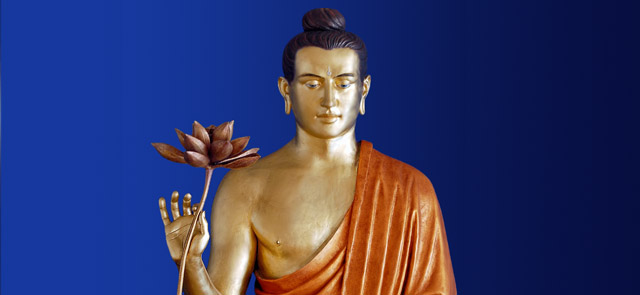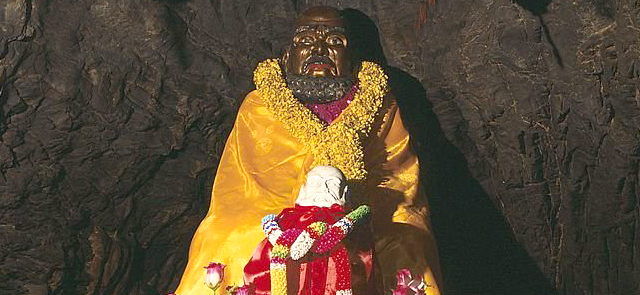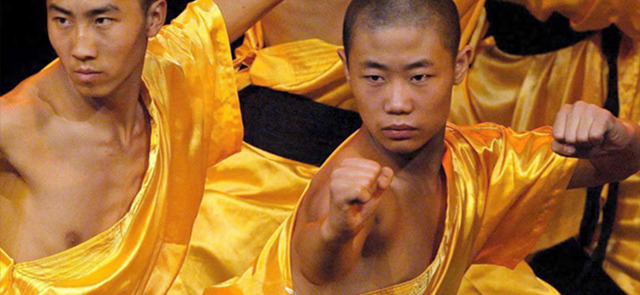The Buddhist Flag, first hoisted in 1885 in Sri Lanka, is a symbol of faith and peace used throughout the world to represent the Buddhist faith. The six colours; Blue (nila), Yellow (pita), Red (lohita), White (odata), Scarlet (manjestha), and the mixture of these six colours (prabaswara) of the flag represent the colours of the aura that emanated from the body of the Buddha when He attained Enlightenment under the Bodhi Tree. The Horizontal Stripes represent the races of the world living in harmony and the Vertical Stripes represent eternal world peace. The colours symbolize the perfection of Buddhahood and the Dharma.
The Blue light that radiated from the Buddha's hair symbolises the spirit of Universal Compassion for all beings.
The Yellow light that radiated from the Buddha's epidermis symbolises the Middle Way which avoids all extremes and brings balance and liberation.
The Red light that radiated from the Buddha's flesh symbolises the Blessings that the practice of the Buddha's Teaching brings.
The White light that radiated from the Buddha's bones and teeth symbolises the Purity of the Buddha's Teaching and the Liberation it brings.
The Orange light that radiated from the Buddha's palms, heels and lips symbolises the unshakable Wisdom of the Buddha's Teaching.
The Combination Colour symbolises the universality of the Truth of the Buddha's Teaching.
Therefore, the overall flag represents that regardless of race, nationality, division or colour, all sentient beings possess the potential of Buddhahood.
The Importance of Flags
The Flag is a recurring item of buddhist cult, dangling from the ceiling or temples' columns inside, or from a pole outside. Flags represent Buddha's virtues and mark out for him, in the same manner the military flags signalize the army's chief; flags also stand guard at Buddha's pictures. Buddhist scriptures list five types of flags: lion's, Makara monster's, dragon's, Garuda bird's, bull's.
Flag is a traditional offering to Buddha by the devouts, together with flowers and incense. As already mentioned, the flag represents the virtues of Buddha and the virtues the devout wants to obtain, therefore flag has a very important ritual meaning: it can prolong devout's life in order to let him increases his merits. This is the case of Indian Emperor Asoka (272-231 B.C.) who lived 12 years more after a serious illness so he could build new other reliquaries (stupa). A flag dangling into a temple at the moment of a devout's death, adds merits to him and even makes him be born again in on of Buddha's paradises. In fact flags are ornaments of famous Buddha Amithaba's paradise. In Tantric Buddhism adepts' head is touched by a flag, as it was an unction.
Who designed the Buddhist Flag?
There appears to be a controversy over as to who designed the Buddhist Flag.
The Buddhist revivalist movement was first headed by Ven. Weliwita Saranankara Thera, who produced scholar monks to spread Buddhist learning throughout the country. However, the arrival of the British in 1796, negated the process. The British set about undermining Buddhism by getting Christian missionaries to take over the educational system. Education and employment opportunities were given as rewards to new converts. The situation at the time was such that a visiting French journalist has gone on record as having stated that the Sangha did not have the vitality for saving Buddhism. J. Barthelmy Sainte-Hilaire, who said so, was to be proved wrong.
In the latter part of the 19th century, Buddhist revivalism came to the fore with Scholar Monks such as Ven. Hikkaduwe Sri Sumangala Thera, Ven. Yatramulle Sri Dharmarama Thera and Ven. Waskaduwe Sri Subhuthi Thera, influencing the process. Anagarika Dharmapala and Valisinghe Harischandra too made a great impact on the movement. The debates at Baddegama and Gampola had far reaching effects whilst the Panadura Debate in 1873 at which Ven. Migettuwatte Sri Gunananda Thera the erudite speaker, backed by Ven. Hikkaduwe Sri Sumangala Thera, won the day for the Buddhists, was crucial. It was this debate that brought Henry Steele Olcott, a retired American Army Colonel to Sri Lanka in May 1880.
Olcott embraced Buddhism and joined the Buddhist revivalist movement and pioneered Buddhist education. Ananda, Nalanda, Mahinda and Dharmaraja stand as monuments to his pioneering efforts.
In 1884, the Buddhists succeeded in getting the British rulers to declare Vesak Poya Day as a Public Holiday as from May 1885. At this stage the Buddhists established the 'Colombo Committee', the members of which were: Ven Hikkaduwe Sri Sumangala Thera (Chairman), Ven. Migettuwatte Gunananda Thera, Don Carolis Hewavitharana (father of Anangarika Dharmapala), Andiris Perera Dharmagunawardhana (maternal grandfather of Anagarika Dharmapala, William de Abrew, Charles A. de Silva, Peter de Abrew, H. William Fernando, N. S. Fernando and Carolis Pujitha Gunawardena (Secretary). This committee set about the task of evolving a Buddhist Flag to be hoisted on Vesak Full Moon Day, 28th May 1885, the day declared as a Public Holiday, for the first time.
Thus it is this committee that jointly designed the Buddhist Flag and of course, Carolis Pujitha Gunawardena, as Secretary of the Committee presented it to the public as approved by the 'Colombo Committee' on 17th April 1885.
The Buddhist Flag, so designed, was hoisted for the first time on 28th May 1885, Vesak Full Moon Day, by Ven. Migettuwatte Gunananda Thera at Deepaduththaramaya in Kotahena. On a suggestion by Olcott the flag was modified to be of the normal size of National Flags. The Buddhist Flag so modified was hoisted on Vesak Full Moon Day in 1886. It remains unchanged up to date.
Professor G .P. Malalasekera was instrumental in making it the Flag of the Buddhist World. His proposal at the meeting of World Federation of Buddhists held in Kandy on 25th May 1950, to accept it as the official Buddhist Flag, internationally, was adopted and since then it has received international recognition.







